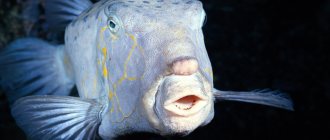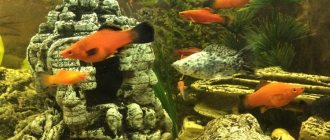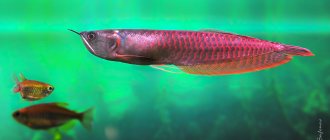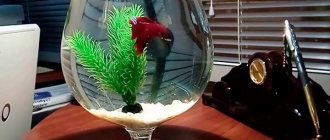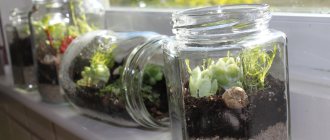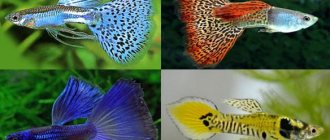Home/FISH/Predatory aquarium fish: photos, names, videos
Predatory aquarium fish attract the eye with their exotic appearance and behavioral characteristics. They jealously guard the territory, quickly rushing to attack. It is very interesting to watch such active pets. Some species can recognize the owner and react to his approach.
Popular types
To begin with, here are the features of the most popular predatory aquarium fish: photos with names, habitat, appearance.
Arowana
Rare and elite breed. Its history goes back about 25 million years. Habitat: freshwater bodies of South America, Australia and parts of Asia. Decorative arowana reaches 100 cm in length. Her body is elongated, reddish-silver in color. It feeds on small fish, crayfish and insects, and is very aggressive. Considered a symbol of prosperity and wealth in Feng Shui.
Astronotus
The cichlid family lives in the rivers and lakes of Paraguay and Venezuela. In captivity it grows up to 30 cm. It has a large, voluminous oval-shaped body, a wide range of colors - from silver to black with a yellow tint. Extremely difficult to breed - aggressive, voracious, destroying plants and tank decor. It feeds on pollock, cod, squid, navaga, etc., and also eats beef offal.
Auratus
Also classified as cichlids, native to Lake Malawi in Africa. Loves water highly saturated with oxygen. It is small in size for carnivores - up to 10 cm. The color is yellow-golden, with a bluish stripe on the side. Males are darker than females. Auratus is active, warlike, and requires a wide range of space.
Bryzgun
It got its name because of its hunting method - the fish shoots a stream of water at the victim, knocks it down and eats it. Lives in the swamps of Asia and northern Australia. It is distinguished by its silver color with vertical black stripes. Feeds on insects. In search of prey, it can jump out of the aquarium - the water level for its maintenance must be low and the walls must be high.
Pseudotropheus
Also found in Malawi, it is a cichlid. The body is elongated, the color is blue-black stripes on a yellow or blue background. Grows up to 15 cm. In addition to live food, it also loves plants. Males are especially fierce in defending their territory, so they are planted in a ratio of at least 3 females per male.
Tropheus
Lives in Lake Tanganyika, Africa. With age, the color changes - juveniles are dark with blue markings, and adults have a black body, a blue head and a wide vertical yellow stripe. The reservoir for tropheus should be large, the bottom should be lined with large stones. The water is saturated with oxygen. Tropheus feed on algae and do not tolerate high protein content.
Basic content rules
The term “predator” itself evokes associations with hunting, danger, and aggression. In context, carnivory means the presence of meat in the diet.
Predatory fish, even aquarium fish, are larger than their relatives, so the tank for keeping them must be of a suitable volume. In this case, it is necessary to take into account various factors: the aggressiveness of the species, the size of the individuals, whether they live in a flock, in pairs or alone. So, to grow 1 apterotonus, you will need an aquarium of at least 200 liters, and for dwarf tetradons 10 liters per individual is enough, but these are school predators.
Look at these predatory beauties.
Other varieties for the aquarium
Now a few words about less popular predatory fish for the aquarium.
Piranha
Belongs to the Cyprinidae, lives in the Amazon and African rivers. It grows up to 30 cm, the sides are slightly flattened, and are distinguished by large, sharp teeth. The color is dark gray, the red belly is especially popular, with a bright red tint in the lower part of the body. Kept in flocks, preferably kept in a species tank. Piranha feeds on small fish, beef, and worms.
Knife fish
Another name is Black Knife. The narrow and elongated body of a bluish-black hue fully justifies this name. The above breed does not have a dorsal fin or scales. Belongs to the electric family. Its habitat is the basin of the Amazon and Parana rivers. Can reach up to half a meter in length. Lives at the very bottom, hiding in thickets of algae, feeding only on live food.
Snakehead
The order Perciformes, the habitat is very wide - from India and Congo to China and Siberia. It got its name because of its elongated body and voluminous scales on its head. The color is brown and gray, grows on average up to 30 cm. A special feature of snakeheads is the ability to breathe atmospheric oxygen.
Anabas
The second name is slider. She received this nickname for her ability to crawl not only on land, but also through trees, in search of better conditions. Lives in southern Asia and the Philippines. The body shape is similar to cichlids. The color ranges from green to brown, the body is intersected by several vertical stripes. When kept in an aquarium, it is necessary to maintain a significant distance from the water level to the glass lid.
Tetraodon
An unusual breed from the four-toothed family. The habitat is similar to Anabas. It has an ovoid body shape and modest dimensions for a carnivore - up to twenty centimeters. It has no scales, but is equipped with many sharp spines located on the back and abdomen. When there is danger, it swells up like a balloon. Color is brown or green with dark spots, the belly is much lighter.
Clarid catfish
Found in Asia and Africa. The body of this catfish is eel-like, the fins are long, and the pectoral fins are equipped with large spines. The color of the skin is grayish-brown. Domestic clarius reaches 70 cm. They are night hunters, strong and pugnacious. Compatible only with representatives of larger varieties.
Crescent-tailed barracuda
Comes from the rivers of the South American continent. The body is long, up to 27 cm, the fins are sharp. The color is pinkish-gray. It feeds exclusively on fish. One of the easiest predators to keep, it has a relatively peaceful character. Requires a lot of space and freedom of movement.
Sacbranch catfish
Lives in south-eastern waters of Asia. In captivity, its height reaches 35 cm. The colors are dark gray, brown and albino. The body shape and movements of this catfish resemble a snake. It has thick mustaches on its head and poisonous spines on its fins. They like to lie on the bottom, in thickets or snags.
Shilb striped
Range – western part of Africa. The height of the shilba can reach 30 cm. It belongs to the catfish, has an elongated body and mustache. The pectoral fins of the shilba are saturated with poison. The color is brownish or gray, with horizontal stripes of a silvery tint. Not too aggressive, needs a large and long aquarium.
Belonesox
Decorative pike is viviparous. It lives in the waters of Mexico and Nicaragua. It grows up to 20 cm, with females being much larger. It is very elongated in length, the color is brown, with a green-bronze sheen. Swims near the surface, does not collect food from the bottom. Females are extremely quarrelsome and can pose a serious danger even to their own species.
Polypterus
It is found on the algae-overgrown bottom of water bodies in Africa and India. The serpentine body of Polypterus ends with a large head. The color is yellowish-gray. Its dimensions do not exceed 90 cm. It has an unusual serrated fin on its back. Breathes oxygen at the surface of the water.
Golden Leopard
From the genus of cichlids, lives in the African Lake Malawi. Grows up to 25 cm, the coloring of this cichlid resembles the skin of a giraffe - dark markings on a yellow background. Requires a tank volume of at least 500 liters. The golden leopard is kept in a group of a male plus several females; the presence of other males, or individuals of other breeds will lead to clashes.
Silver Aravana
Range: large rivers of South America. It has impressive dimensions - about 120 cm. A pronounced predator, it hunts all living things that are smaller in stature. The silver color of the Aravana's scales changes with age in different shades - from reddish to blue. It should be noted in the content that the Aravana often jumps to the surface for prey.
Toadfish
Lives in the waters of the Pacific and Atlantic oceans, from the coast of Australia to Thailand. Approximately 30 cm in length, a third of the body is occupied by a huge head, the entire skin is covered with asymmetrical growths and equipped with spikes with poison. Its color ranges from yellow to dark beige, with black random patterns. Likes to hide in plants and rocks at the bottom.
Exodon paradoxical
It lives in the Brazilian and Guyanese parts of the Amazon. It got its name for its strange behavior: despite its gregarious nature, exodon is quite aggressive, and its small size (10 cm) does not stop it from attacking larger representatives of the underwater world. The color of the exodon is silver, the fins are reddish, and there are black markings on the side and at the tail.
Carapace
Another name is armored pike, or alligator. The scientific name of the class is Atractosteus. Found in water bodies of the North American continent. The smallest type of carapace reaches a length of about 80 cm. Its body is covered with hard scales, its color is olive-brown with a pattern of diamond-shaped scales. The carapace leads a sedentary lifestyle.
Freshwater Garfish
Or needlefish. Found in Asian and Indian rivers and the Black Sea. It has a narrow, long body of a greenish-silver hue and a height of up to 30 cm. The teeth of the Sargan are very sharp, so you should be careful with it. Sometimes it jumps out of the aquarium, so it's worth using a lid.
Vampire fish
In another way - Payara. Range: South America. It got its name because of its teeth, which are at least 15 cm long. Payara’s body is oval in shape, greenish-gray in color. In captivity it reaches 75 cm. It is extremely difficult to maintain and rarely lives longer than three years. Prefers strong currents.
Aristochromis Christie
Found in Malawi. Height is 30 cm, the color of males is blue, females are grayish, both have a black horizontal stripe along the entire body. Prefers sandy soil and rocks at the bottom. Harems contain a male plus three or four females. If there is significant free space, it gets along peacefully with larger breeds.
Trahira (wolf fish)
Found in South American waters. It grows up to 50 cm and is distinguished by a very large head with a powerful jaw. Grayish scales with ink splashes can change tone depending on age and area of residence. Trahira is able to get along with large, peaceful neighbors.
Feeding
Among cichlids there are omnivorous, herbivorous and predatory fish. Therefore, when choosing a diet, you need to take into account the species of your pets. Predators (American cichlids, cichlids and some African cichlids) feed on crustaceans, mollusks, zooplankton and small fish. With a lack of protein in the diet, they begin to lag behind in growth and development.
Herbivorous species include Malawian cichlids of the Mbuna group (labidochromis, melanochromis and pseudotropheus). The diet of these fish should consist of 60-70% plant foods.
Depending on the species, the menu of aquarium cichlids should include tubifex, daphnia, bloodworms, chopped pork or beef heart, spirulina, zucchini, cucumbers and vegetable granules.
To make the task easier, you can use ready-made specialized food:
- Tetra Cichlid Stick is the main food for predatory fish;
- Tetra Cichlid Color – food to enhance the color of golden-orange, yellow and red cichlids;
- Tetra Cichlid Mini Granules – food for dwarf cichlid species;
- Tetra Malawi – food for herbivorous cichlids.
It is recommended to feed aquarium cichlids 2-3 times a day, and the serving size should be such that it is eaten without residue within 3-5 minutes. It is advisable for representatives of large species to do weekly fasting days.
Specifics of keeping predators
Carnivores require special attention to conditions in captivity.
Here are some important points:
- careful selection of neighbors: most predators are kept only in a species aquarium, or with larger breeds;
- it is also advisable to keep one male for several females - there is fierce intraspecific competition among these breeds
- carnivores prefer live food and have an excellent appetite—considerable amounts of money will be spent on food;
- Many breeds of hunters jump out of the water in search of food.
Predators are usually expensive and difficult to keep, requiring a lot of space and food.
Feeding
Typically, carnivores feed on small fish, less often on beef and offal, and sometimes add plant foods to their diet.
Below are popular recommendations for feeding carnivores:
- The diet should include live food - for example, goldfish;
- It’s worth feeding your pets on time and to the full amount - otherwise they will attack their neighbors in the tank;
- crustaceans, mollusks, shrimp, plankton would be a good option;
- It is not recommended to give fish meat from mammals or birds;
- Most predators are fed twice a day.
In the case of those species that swallow prey whole, such fish are fed no more than two or three times a week. You also need to ensure that leftover food does not clog the aquarium.
Conditions
As for other aspects of keeping predators, this also has its own subtleties.
Here are the most significant of them:
- carnivores love space - they are kept in large aquariums with a volume of at least 80 liters;
- Only people like them can coexist with predators - everything that is smaller in size is perceived as food;
- such fish prefer silence and dim light;
- the scenery must have shelters, where nocturnal species will rest during the day, and ambush lovers will find shelter;
- carnivores produce a certain amount of organic waste - you will have to purchase more powerful filters.
Otherwise, you need to focus on the needs of each individual species. And be careful with your fingers - carnivores have sharp teeth and a cantankerous character.
Breeding
Predators are extremely difficult to breed. Some species do not spawn in captivity, others eat their partner after spawning. A couple of weeks before spawning, the pair is placed in a separate spawning tank and intensively fed with high-quality live food. Cichlids tend to hatch eggs in their mouths. The fry feed on brine shrimp, cyclops and daphnia. As soon as the fry hatch, the adults are placed in a common aquarium - they can eat the fry. Viviparous fish mate in a common tank, but the female is placed in a spawning tank a couple of days before the young are hatched.
Content Rules
It is best to place an aquarium with predators in a quiet place with good lighting. For decoration, you can use decorative driftwood and stones, arrange secluded places, and place broad-leaved plants.
When choosing the size of the aquarium, you should consider the following factors:
- level of aggressiveness of the species;
- adult size;
- preferences for living with relatives (single, pair, harem, flock).
There are the following unspoken rules for aquarists:
- the larger and more aggressive the fish, the larger the volume of the aquarium should be;
- proximity to small fish is undesirable, except in cases where they are introduced as potential food.
Important! Aquarium predators require adequate nutrition, otherwise they will begin to engage in cannibalism, tearing out each other's fins.
Temperature
The average water temperature in an aquarium containing predatory aquarium fish should be 24–27 C. Most ornamental fish are accustomed to the warm and humid climate of their native tropics, so they cannot live in cold water.
Attention! Most heat-loving aquarium fish may begin to get sick due to a decrease in water temperature, and even die if there are constant temperature fluctuations.
It is not allowed to keep cold-loving and warm-water species together in the same aquarium. The water must be saturated with oxygen in sufficient quantities, so filters and aeration are important.
Filtration and aeration
Most aquarium predators require a powerful filter in the aquarium: a high level of water pollution is destructive for some species.
There are signs by which it is possible to determine that the fish do not have enough oxygen. Its deficiency is obvious if the deep-sea inhabitants of the aquarium begin to spend a lot of time in the upper layers of water and take oxygen from the surface.
It is important to regularly test the water for the presence of harmful impurities: nitrates, chlorine, as well as ammonia and iron. It is not necessary to change all the water in the aquarium; it is enough to replace half and then take repeated measurements. If the indicators do not return to normal, it is necessary to increase aeration. In addition to the direct cleaning function, this procedure involves the elimination of unpleasant odors. Aeration of water allows you to increase the percentage of oxygen, which has a positive effect on the living creatures in the aquarium, in particular, it makes it easier for fish to breathe.
Compatibility in a community aquarium
Along with predatory species, the aquarium usually contains the same carnivorous fish. Herbivores are introduced only if they are the same body size as their dangerous neighbors or larger.
Usually predators do not attack their fellows and peaceful fish, there are a number of objective reasons for this:
- Lack of food. The predator should always be full, then he has less reason to start hunting for other fish.
- Territorial section. This problem is solved, first of all, by a sufficient volume of the aquarium: the larger the territory, the less the need to organize a war for its redistribution.
- Spawning or protecting their offspring. Equipping the aquarium with a sufficient number of shelters and refuges will help: the more places where you can hide from an aggressive female overwhelmed by maternal instinct, the fewer problems.
- Conflict between males of the same species. Natural selection can only be fought through the proper distribution of individuals. (for example, the harem method of dispersal, when there are three or more females per male).
Of course, these are not all factors. It is often impossible to predict the behavior of fish that attack smaller species, obeying natural instinct. But still, in order to successfully combine the residence of predators with other fish, care should be taken to reduce provoking situations to zero.
